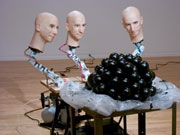![]()
Talking heads spout `wisdom'
By Joanne Silver/ Visual Arts
Friday, September 17, 2004

In one room, an argument is brewing between a man and a woman. In the next room, 22 voices share their sexual fantasies - in tones as passionless as a computerized telephone message. The final chamber features three characters exploring a mysterious object in front of them as they speculate about the nature of violence. Nothing gets resolved in any of the conversations, but the memory of them is hard to shake.
Welcome to the strange world of Ken Feingold. Art and artificial intelligence meet in the haunting installations he creates, three of which are on display through Oct. 23 at the School of the Museum of Fine Arts. Substituting ventriloquist puppets and animatronic heads for actual human beings, the artist designs original computer programming to breathe something akin to life into their rather bloodless souls.
``The conversations that these figures carry on are neither scripted, nor are they random,'' Feingold explained. ``Rather, the software gives each a `personality,' a vocabulary, associativehabits, obsessions and other quirks of personality.''
Isolated from the entirety of a person, these quirks and obsessions loom large. Discussions that start out innocently enough become claustrophobic. Fantasies shed all sense of fun. Habitual disagreements turn toxic. Feingold's characters keep talking, but they rarely listen. That role is left for the viewer, who represents the best chance for any resolution to the endlessly debated topics. In matters ranging from philosophy to sex, the unprogrammed passer-by silently enters the discussion. Artificial intelligence may be fueling the discourse within the galleries, but real intelligence isrequired to understand any of it.
``The Animal, Vegetable, Mineralness of Everything ''focuses on three heads - nearly identical self-portraits of the artist, in which only the eye color varies. These heads, in turn, focus on a paint-spattered blob of black spheres, which resembles a sloppy model of a molecule. Silicone eyelids blink and mouths move, animated by the inhalations and exhalations of an air compressor. The heads converse - sort of: ``What are you thinking about?'' ``What is that thing, really'' ``Is it looking at us?'' ``Good question.'' ``Is it an animal?'' ``Is it a contest?'' ``Are we the only ones that imagine life?'' ``That thing is very vestigial.'' In between non sequiturs, bits of wisdom pop up - just as they do in the course of everyday activities. Out of the mouths of robots, the mundane and the philosophically profound emerge in the same flat intonations.
Feingold probes more than cybergamesmanship with hisbizarre split personalities. He has spent time in India, lived withTibetan monks, studied Buddhism and Kant and Western psychoanalysis. Through such beings as the arguing look-alike heads in ``You'' - one with a female voice, one with a male - the artist has found a sly means of investigating existential issues. Concepts including the nature of the self and the other, love, sex, death and violence drift in and out of his characters' attempts at communication.
copyright 2004 Boston Herald